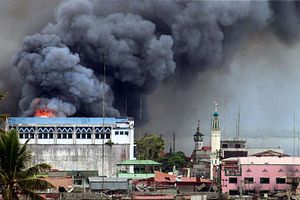On Monday, the Philippine military confirmed that it had killed two top commanders from the Islamic State (IS or ISIS) in the southern city of Marawi, where a siege by IS-linked militants has been ongoing since May. Though the death of the two leaders is a severe blow for the group and constitutes significant progress in ongoing battle for Marawi, IS still remains a potent threat and poses a major challenge for Southeast Asian states.
As I have noted before, though worries about IS in Southeast Asia had existed even dating back years prior, the Marawi crisis was a big wake-up call for the subregion (See: “Singapore Warns of Islamic State Base in Southeast Asia”). It heightened fears of the establishment of a territorial foothold for the Islamic State in Southeast Asia and exposed the severe limitations of Philippine military capabilities to contend with it (See: “Why Has the Philippines’ Military Struggled in its Terror Fight Against Duterte?”).
While Armed Forces of the Philippines (AFP) had already been indicating that they were close to finally ending the battle for Marawi despite repeated postponements, the confirmed deaths of two top IS leaders are no doubt significant. Isnilon Hapilon, a leader of the southern Philippine militant group Abu Sayyaf, had emerged as the IS’ so-called “emir” in Southeast Asia, while Omarkhayam Maute was a leader of the Maute group in the southern Philippines that had pledged allegiance to IS and joined forces with it to mount the Marawi siege.
Yet any sort of triumphalism at this stage – including President Rodrigo Duterte’s premature declaration of the “liberation of Marawi” – should be met with skepticism. Though these leaders may be dead, others exist and can simply take their place within the IS hierarchy. Among the notable candidates is Mahmud Ahmad, a well-connected, battle-hardened Malaysian university professor turned militant who financed the Marawi siege and remains at large.
And though the Duterte government may expect the battle for Marawi to be wrapped up in its favor in the coming days, the risks in the southern Philippines remain. One of the top short-term concerns of defense officials both in the Philippines and the region more generally has been the threat of radicalization among the hundreds of thousands of displaced citizens, which can only be properly managed with a robust reconstruction and reintegration effort.
Furthermore, amid anxieties over retaliatory attacks and the emergence of splinter groups, a greater focus will also need to be placed on how the Philippine defense establishment can better bridge its well-known gaps, including boosting the intelligence capabilities that had been called into question during the Marawi crisis and improving urban warfare training (See: “Battle for Marawi Exposes Philippines’ Military Intelligence Crisis”). This has been a costly exercise for the AFP, and the focus should now be on how it can better detect and manage future threats before they get to a crisis.
In addition, with two raging insurgencies in the southern part of the country with Muslim and communist-linked militants, it is worth underlining the point that the breeding ground still exists for future militancy. Addressing these – which are rooted not just in contemporary terror threats, but governance issues that date back decades and have deep political and socioeconomic roots – will need to be a priority. Despite the simplistic portrayal in media accounts of the Maute group being the primary antagonist in the battle for Marawi, if anything it reinforced the point that the allegiances between it and other groups as well as foreign militants are much looser.
Accomplishing all this and managing the broader Islamic State threat in Southeast Asia will no doubt require a more robust regional and broader international effort. This is especially the case as IS seeks to regroup and potentially find other territorial footholds in ASEAN states following defeats in the Middle East, with the help of both IS fighters returning from abroad or sympathizers at home (See: “ASEAN’s Islamic State Conundrum”).
While some of this is already underway, be it in terms of equipment to boost Philippine intelligence, surveillance, and reconnaissance capabilities or wider trilateral cooperation among the Philippines, Malaysia, and Indonesia, there are still clear limitations and challenges that need to be overcome in this regard to counter terrorism and violent extremism (See: “Confronting Threats in the Sulu-Sulawesi Seas: Opportunities and Challenges”). Because even as the battle for Marawi itself winds down, the wider war against the Islamic State and its affiliates continues and must be fought effectively and decisively.
































